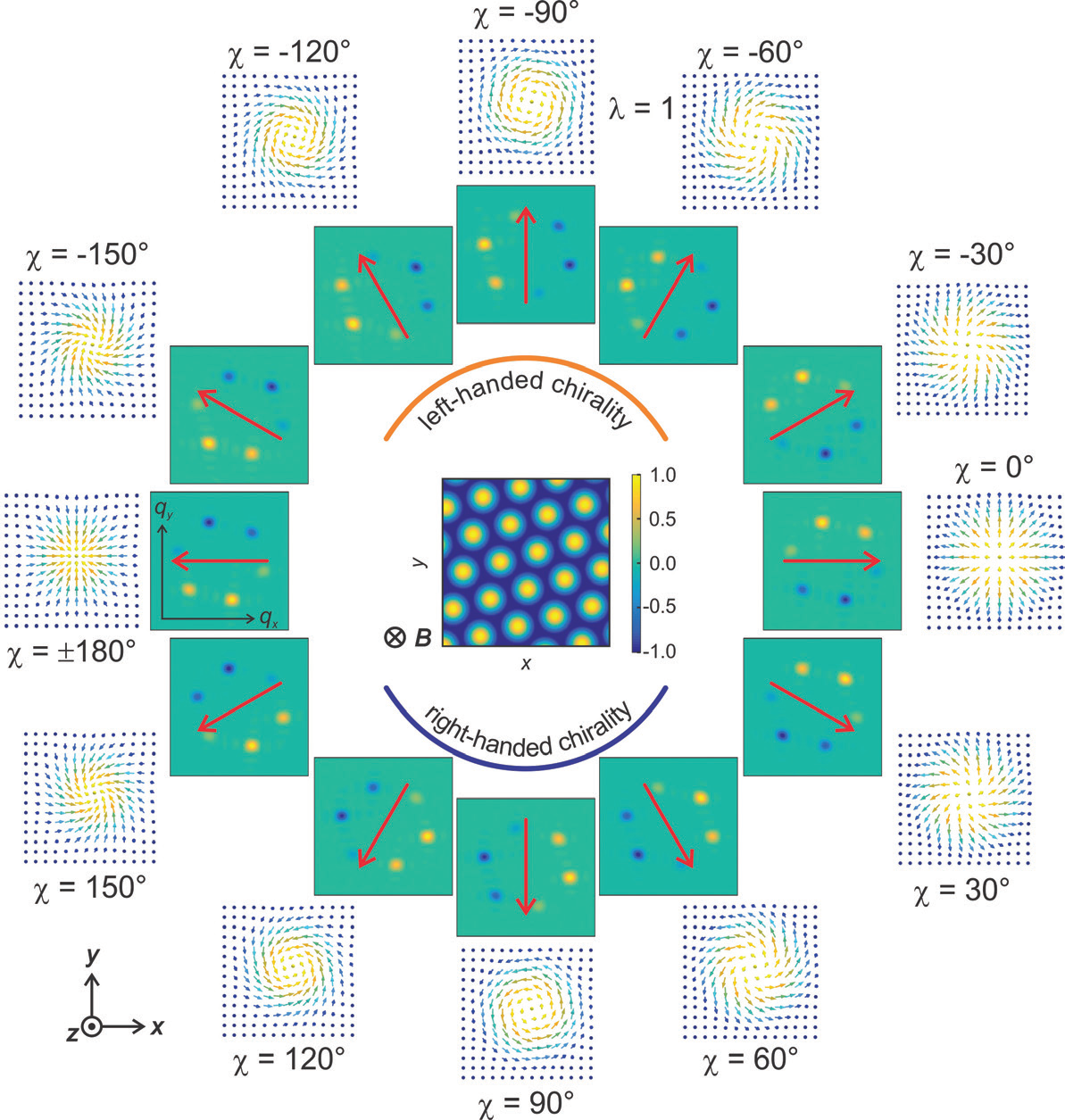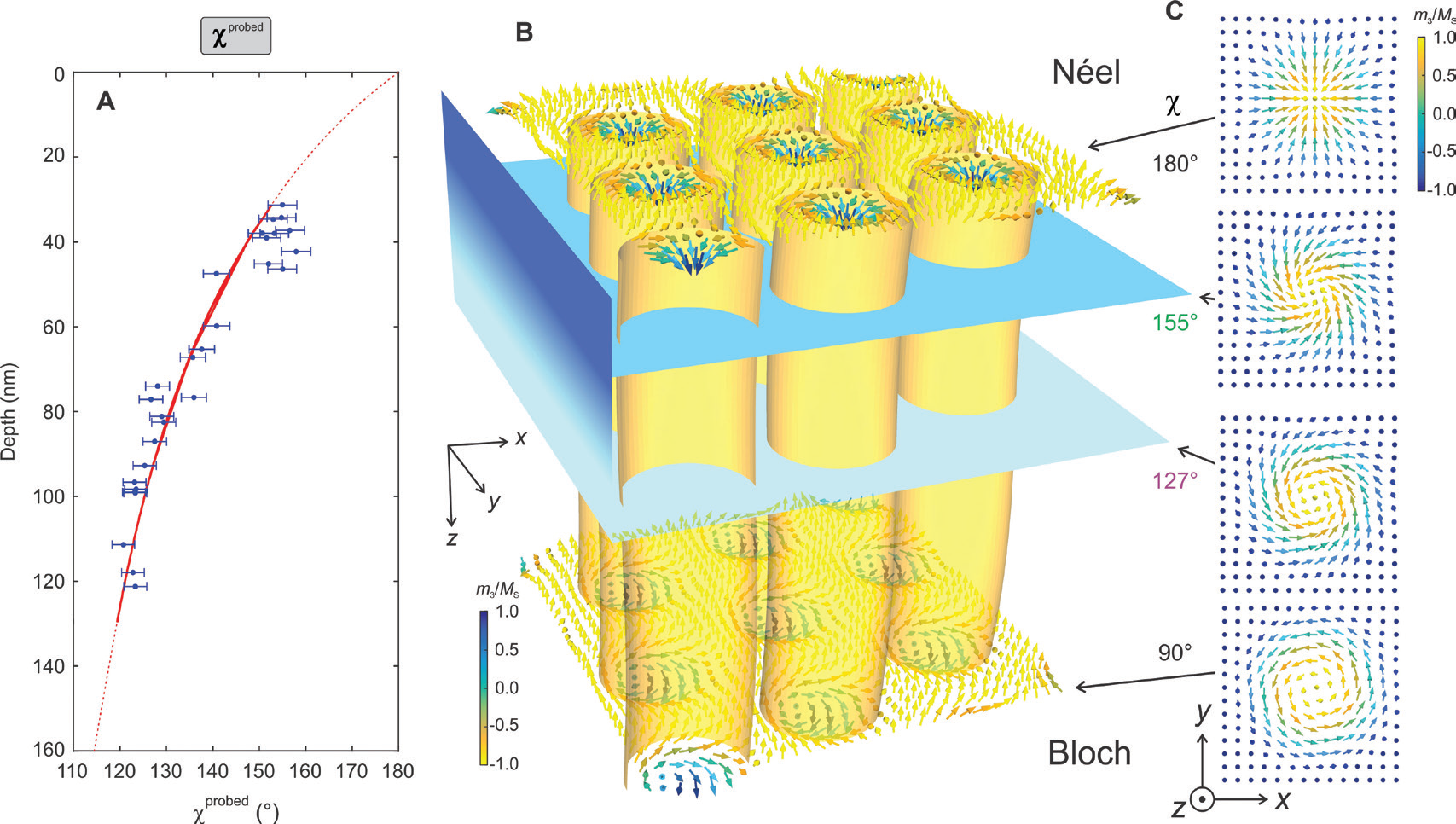Keep up to date with the latest research and developments from Diamond. Sign up for news on our scientific output, facility updates and plans for the future.
Magnetic skyrmions are promising candidates for the next generation of memory devices as they allow increased storage density, and require less energy. The established methods for studying skyrmions, e.g. neutron diffraction and electron microscopy, are not sensitive to the near-surface region of a sample, which is the area most relevant for applications.
In order to characterise the 3D structure of the skyrmion lattice for the first time, an international team of researchers established a new X-ray technique for the direct measurement of the helicity angle – a quantity that is characteristic for the different types of skyrmions. They then made use of the uniquely tunable surface-sensitivity of soft X-rays, tuning the energy of the incident X-rays across the absorption edge, while carrying out circular dichroism of resonant elastic X-ray scattering peak technique. This allowed them to fully reconstruct the detailed structure of the skyrmion lattice as a function of depth, information crucial for enabling future skyrmion-based devices.

The discovery of skyrmions in chiral magnets, featuring non-trivial topological winding described by a highly unusual emergent electrodynamics, has inspired tremendous efforts to read, write, and manipulate individual skyrmion bubbles, as well as skyrmionic textures in tailored nano-systems amenable for data storage, transmission, and processing1. So far, skyrmions have been mostly treated as two-dimensional objects that extend into the third dimension forming tubular structures. However, it is well-known that the abrupt change of boundary conditions (truncated crystal) can lead to a shift in atomic positions in order to lower energy, commonly known as a (structural) surface reconstruction. Similarly, magnetic structures at or in the vicinity of a surface may be fundamentally different from the bulk, resulting from broken symmetry or non-continuous properties. Different mechanisms have been discussed as the underlying cause of magnetic surface effects, which depend on the intrinsic and extrinsic properties of the system, and which may be present at the same time, leading to a magnetic surface reconstruction. Their presence has far-reaching implications for the creation of skyrmions in surface-dominated systems. More generally, it identifies surface-induced magnetic effects as an unchartered scientific territory, in particular due to the lack of experimental tools allowing for their study.

Circular dichroism (CD), the difference between the intensities obtained using left- and right-circularly polarised incident light, is known to be sensitive to the chirality of a material. In our experiment, the CD-REXS was obtained by integrating a series of reciprocal-space-map scans for each polarisation separately, followed by normalisation and subsequent subtraction of the left- and right-circularly polarised patterns4. The direct CD-REXS pattern shows six magnetic peaks with varying CD intensities, and a distinct boundary that separates the positive and negative halves. Each χ corresponds to a characteristic CD-REXS pattern, in which a dichroism extinction vector can be defined as illustrated by the red arrows in Fig. 1. Consequently, the orientation of the dichroism extinction vector exclusively reveals the helicity angle, which is a unique characteristic of a skyrmion.
Dr Shilei Zhang, University of Oxford, [email protected]
Diamond Light Source is the UK's national synchrotron science facility, located at the Harwell Science and Innovation Campus in Oxfordshire.
Copyright © 2022 Diamond Light Source
Diamond Light Source Ltd
Diamond House
Harwell Science & Innovation Campus
Didcot
Oxfordshire
OX11 0DE
Diamond Light Source® and the Diamond logo are registered trademarks of Diamond Light Source Ltd
Registered in England and Wales at Diamond House, Harwell Science and Innovation Campus, Didcot, Oxfordshire, OX11 0DE, United Kingdom. Company number: 4375679. VAT number: 287 461 957. Economic Operators Registration and Identification (EORI) number: GB287461957003.